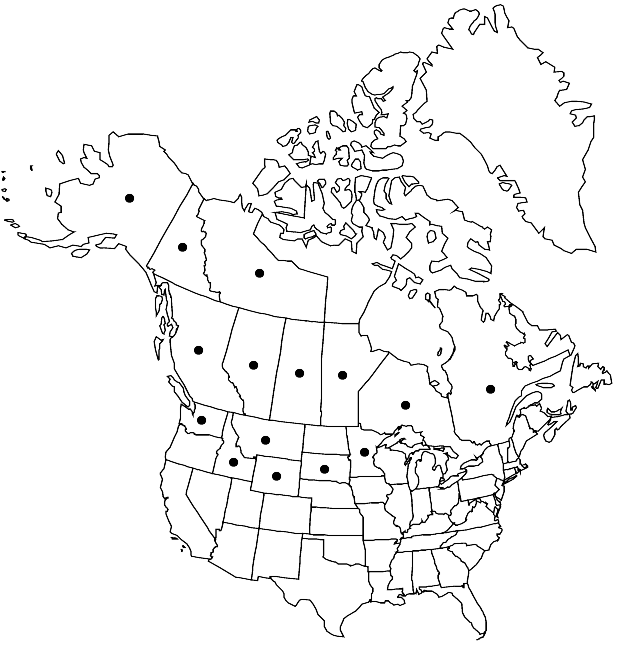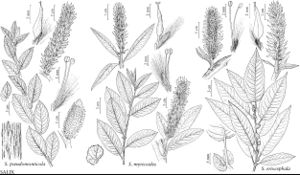Salix pseudomonticola
Contr. U.S. Natl. Herb. 22: 321. 1921.
Plants 1–6 m. Stems: branches red-brown or yellow-brown, not or weakly glaucous, (slightly or highly glossy), glabrous or glabrescent; branchlets yellow-green, red-brown, or brownish, glabrous, pilose, or densely villous, (inner membranaceous bud-scale layer free, separating from outer layer). Leaves: stipules foliaceous, (prominent, 5–9–15 mm), apex rounded to acute, sometimes acuminate; petiole (usually reddish), shallowly grooved, or convex to flat adaxially, 6–20 mm, short-silky or velvety adaxially; largest medial blade broadly to narrowly elliptic, or ovate to broadly obovate, (25–)30–86(–118) × 12–51 mm, 1.4–3 times as long as wide, base convex, rounded, cuneate, subcordate, cordate, or sometimes irregularly lobed, margins flat, serrulate or crenate, apex acute, acuminate, or convex, abaxial surface glaucous, glabrous, pubescent, or pilose, hairs wavy, adaxial slightly glossy or dull, glabrous, puberulent, pubescent, or pilose, midrib hairy; proximal blade margins entire or serrulate; juvenile blade reddish, glabrous or pubescent abaxially, hairs white, sometimes also ferruginous. Catkins flowering before leaves emerge; staminate stout, 16–39 × 10–12 mm, flowering branchlet 0 mm; pistillate densely or moderately densely flowered, slender to globose, 17–73 × 8–20 mm, flowering branchlet 0–5 mm; floral bract brown or black, 1–2.4 mm, apex rounded or acute, abaxially hairy, hairs straight. Staminate flowers: adaxial nectary oblong, 0.3–1 mm; filaments distinct or connate less than 1/2 their lengths, glabrous; anthers purple turning yellow, 0.4–0.5 mm. Pistillate flowers: adaxial nectary oblong, flask-shaped, 0.3–0.8 mm, shorter than stipe; stipe 0.5–0.8–3 mm; ovary pyriform or obclavate, glabrous, beak gradually tapering to styles; ovules 18 per ovary; styles (0.5–)0.7–1.8 mm; stigmas flat, abaxially non-papillate with rounded tip, or 2 plump lobes, 0.1–0.21–0.29 mm. Capsules 4–7 mm. 2n = 38.
Phenology: Flowering late Apr-early Jun.
Habitat: Moist fens in drainageways in white spruce forests, treed bogs, balsam poplar forests, floodplains
Elevation: 0-2500 m
Distribution

Alta., B.C., Man., N.W.T., Ont., Que., Sask., Yukon, Alaska, Idaho, Minn., Mont., S.Dak., Wash., Wyo.
Discussion
Salix pseudomonticola is characterized by precocious flowering; catkins sessile; juvenile leaf blades, petioles, and proximal midribs reddish; stipules prominent; and leaves and branchlets sparsely hairy. Branches older than two years have a distinctive pattern, which consists of a series of longitudinal splits in epidermis produced as the branch expands. The edge of epidermis around the split, where it has separated from the branch, is yellow and contrasts with the red-brown branch to which the epidermis still adheres.
Vegetative specimens of Salix pseudomonticola with yellow-brown branches can be confused with S. famelica. They may be separated by their juvenile leaf margins prominently and closely gland-dotted; stipules usually prominent, sometimes early deciduous; leaves broader (1.4–3 times as long as wide versus 2.6–7 in S. famelica); and petioles slender and often longer in relation to blade length. The possibility of hybridization needs study.
Vegetative specimens of Salix pseudomonticola can be distinguished from S. pyrifolia by juvenile leaves reddish and almost always with some ferruginous hairs, versus yellowish-green and glabrous or with white hairs, and mature leaves usually dull adaxially versus glossy.
Selected References
None.
